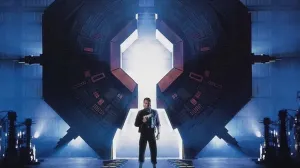Doctor Strange in the Multiverse of Madness catapults into theaters this week, bringing to life the twenty-eighth film within the Marvel Cinematic Universe. As its title alludes, Multiverse of Madness will not only advance the story of Stephen Strange (Benedict Cumberbatch) and his compatriots, but will serve as a unique flashpoint for the MCU, cracking open its live-action multiverse and showcasing other realms where stories can be told. In the process, it will also serve as the first superhero film in over fifteen years for director Sam Raimi, who stepped in to helm Multiverse of Madness following the departure of Scott Derrickson in early 2020. Raimi’s work on Multiverse of Madness has already felt significant on multiple levels — not only because the film’s premise could lend itself perfectly to Raimi’s beloved horror-tinged directing style, but because the film could further highlight the instrumental and genre-defining work he did on Sony’s original Spider-Man film trilogy.
Videos by ComicBook.com
Had there been culturally successful superhero films prior to 2002’s Spider-Man? Absolutely – Richard Donner’s Superman: The Movie cemented DC’s Man of Steel as an icon in 1978, and Tim Burton’s Batman created a self-described “Batmania” in the summer of 1989. Marvel, on the other hand, had not fared as luckily, with its film efforts in those surrounding years consisting of a notoriously-panned Howard the Duck movie in 1986, a TV movie spinning out of The Incredible Hulk in 1988, a comic-inaccurate adaptation of The Punisher in 1989, a 1990 Captain America film that didn’t even earn a theatrical release, and a 1994 Fantastic Four movie created under such specific circumstances that it borders on being an urban legend. Even 1998’s Blade, which was already successful upon its release and has only catapulted further into a cult classic, was a decidedly darker and non-superheroic look at what the Marvel universe had to offer. 2000’s X-Men seemed to move the needle a bit further in the right direction, but it was still wrapped in an awkward sheen of dark leather costumes and inexplicable changes from the source material, all of which almost seemed embarrassed by how weird and wacky Marvel Comics could be.
Enter Raimi’s Spider-Man, which swung into theaters in all of its glory in the summer of 2002, and brought with it all of the aesthetic and tonal quirks that had largely been missing from its recent Marvel predecessors. Instead of stark color palettes and busy black leather costumes, the film was filled with sunset-hued pops of color, lite-rock needle drops, and a distinctly colorful, comic-accurate costume. (Even Willem Dafoe’s Green Goblin’s costume, which had a slightly more armored construction than its comic counterpart, still glistened bright green and unmistakably conveyed “Green Goblin.”) While X-Men had tried a bit too hard to emulate the too-cool-for-school action films that dominated the box office, Raimi’s Spider-Man ran full speed ahead into the other direction, portraying the journey of Peter Parker (Tobey Maguire) as pulpy, dorky, and heartfelt in every possible way.
In and amongst Peter mastering his web powers and becoming a fledgling vigilante, he had to deal with a lot of the usual turmoil of being a teenager: falling in and out of love with his high school sweetheart, mourning the loss of a loved one, and dealing with the disapproval of his best friend’s father. Under Raimi’s direction, this focus not only made the eventual narrative crux of the film (Goblin, who is secretly that aforementioned best friend’s father, accidentally dying in a fight with Spider-Man) more impactful, but it brilliantly emulated the experience of reading a Spider-Man comic, particularly Stan Lee and Steve Ditko’s original work on the character. At the same time, it was profoundly accessible to general audiences, as evident by its record-breaking $825 million box office, and by reviews that dubbed it “disarmingly entertaining”, “a pure popcorn movie”, and “a welcome relief from the usual two-dimensional offerings.” In hindsight, it feels impossible to imagine anyone else outside of Raimi producing such an end result, as his open love of comic books, genre storytelling, and the DIY creativity of filmmaking (as previously showcased with films like The Evil Dead, Darkman, and Army of Darkness), perfectly collided with what a Spider-Man adaptation would require.
At the time, it might have been easy to dismiss Raimi’s inventive and reverential work on Spider-Man as lightning in a bottle, something that could have easily fizzled out if a future sequel failed or if audiences simply stopped caring. That didn’t prove to be the case, as 2004’s Spider-Man 2 was arguably met with even more acclaim, grossing $788.6 million worldwide, being nominated for several Academy Awards, and being regarded as one of the best superhero films ever made. It’s easy to see why that honor was given, between Raimi’s continued use of the first film’s dreamy aesthetics and tone, to the emotional and bittersweet rivalry between Peter and Doc Ock (Alfred Molina), to the handling of Peter’s work-life balance as Spider-Man.
The success of the first two films would then lead to 2007’s Spider-Man 3, which had the honor (at the time) of being the most expensive movie ever made, with a budget of $250 million. In the film, Peter’s future as a young man and as a superhero were placed into the forefront, while having him face off against Sandman (Thomas Hayden Church), a new Green Goblin (James Franco), and Venom (Topher Grace), the latter of whom was added at the studio’s request. While Spider-Man 3 received a much more divisive response than its predecessors (mainly due to the addition of Venom, which overcrowded the movie and took too heavily of a detour in Peter’s story), it still made a whopping $894.9 million, and garnered enough positive buzz to potentially get three more sequels. Even with its faults, Spider-Man 3 proved to be a unique showcase for Raimi’s storytelling abilities, taking things into an even darker, campier, and emotional territory than the past two films. It also showed a wide audience the kind of ever-escalating narrative that runs throughout superhero comics, complete with a crossover of different villains and a satisfying emotional arc for its hero. There’s also no denying how ambitious it was to create and pull off a financially-successful, true-to-the-comics trilogy of superhero films, something that the X-Men and Blade franchises didn’t manage to pull off at the same time.
As countless message boards and fan campaigns continue to prove, Sam Raimi’s work on the Spider-Man trilogy is nothing short of a revelation. Raimi not only proved that Marvel movies could be incredibly financially viable, but they could tonally be Marvel movies at their core, instead of just movies about Marvel characters. In the years that have followed, we’ve seen time and time again that the right character, cast and crew, and reverence for the source material can help audiences fall in love with Marvel characters — a successful formula that Raimi originally provided could work. As Sam Raimi’s Multiverse of Madness is about to offer an almost postmodern take on what superhero movies have become, it’s hard to deny that that would have looked wildly different without his work on Spider-Man.
Want to learn more about Doctor Strange and Scarlet Witch’s latest adventure in the Marvel Cinematic Universe? Check back on ComicBook CRAM every day leading up to the premiere of Doctor Strange in the Multiverse of Madness and click here for even more content to find out everything you need to know about the new movie!








